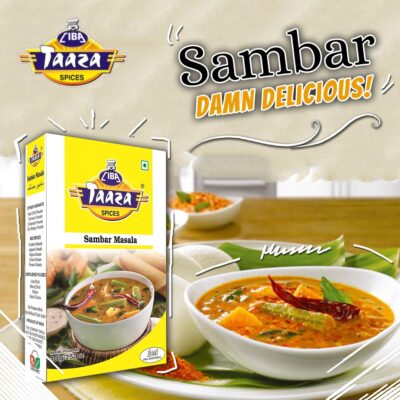Sambar

Sambar is a lentil and vegetable stew from South India made with lentils, tamarind, and a special spice mix known as sambar powder. It is a common and well-liked dish in many South Indian households and also in other parts of the Country.
A simple sambar recipe would include lentils, tamarind, sambar powder, and a few spices, as well as a mixture of one or two types of vegetables. A decent sambar powder produces a good and tasty sambar every time. So, when making it, make sure you use a strong aromatic sambar powder.
Sambar is healthy and nutritious, as it is made from both lentils and vegetables, and is high in protein as well as other nutrients such as vitamins and minerals. Sambar is a full meal when eaten with rice or idli.
How it is made
Vegetables and lentils are cooked separately in a simple sambar recipe. Lentils are boiled until they are mushy and mixed.
Mixed cooked carrots, mashed dal, tamarind pulp, and sambar powder are mixed together and cooked over low flame for a few minutes.
In the end, tadka is made in oil with mustard seeds, curry leaves, asafoetida, and dry red chilies. This tempering or tadka is added to the sambar.
Ingredients
- Ciba Spices
- Ciba Taaza Sambhar Masala
- Yellow pumpkin
- Carrot
- Ash gourd (white pumpkin)
- Drumstick
- Pearl onions, shallots,
- onions
- Radish
- Tomato
- Okra (lady fingers)
- Potatoes
- Brinjals (eggplant)
- Snake gourd
- Spinach
- Amaranth leaves
- Bottle gourd
- Banana stem
- Tamarind pulp preparation
It’s always a good idea to soak the tamarind in water before starting to make sambar. Soak 1 tablespoon tamarind for 20 to 30 minutes in 1\3 cup hot water. Once the tamarind has softened, squeeze it in the water itself. Remove the tamarind pulp and discard the strained tamarind.
Cooking Daal and Vegetabels
- Rinse ½ cup tuvar dal (100 grams) a couple of times in water.
- In a pressure cooker, drain all the water and add the dal. Also, add 1/4 teaspoon turmeric powder. Add 2 to 3 cups of water.
- Cover and cook dal on a medium flame for 10 to 12 minutes or 7 to 8 whistles.
- Once the pressure settles down, open the pressure lid. The dal now must be fully cooked and mushy. Cover the dal and keep aside.
- Take 1 to 1.5 cups of chopped vegetables of your choice in a pan. Add one sliced medium onion and one sliced medium tomato.
- Add ¼ teaspoon turmeric powder, ¼ teaspoon Kashmiri red chili powder, and salt as per taste. Kashmiri chili powder brings nice bright color to the sambar.
- Add 1.5 to 2 cups water and stir. Add enough water so that they cover the vegetables.
- Continue to cook the vegetables in the pan on a stovetop over a medium-low to medium flame, keep checking the vegetables while cooking.
- Cook the vegetables until they fully cooked. Make sure the vegetables aren’t overcooked.
- Add the prepared tamarind pulp and mix well. Add 1 to 1.5 tablespoon of sambar powder. Stir and mix the ingredients well. Now, add the cooked mashed dal to the mixture and stir and mix well.
- If the consistency tends to be too thick, apply more water. You can adjust the amount of water to achieve a medium to thin sambar consistency.
- Cook the mixture over medium-low heat until it starts to boil. Stir at frequent intervals. Once the mixture forms a frothy layer on top, switch off the heat. Cover with lid and set aside. Taste and season with salt if necessary.
Tadka
- In a small pan, heat 2 tablespoons of oil. You can use sunflower oil, ghee, or coconut oil.
- Add ½ tsp mustard seeds and let the seeds crackle.
- Now add 1 to 2 dry red chilies.
- Now add 10 to 15 curry leaves, 4 to 5 fenugreek seeds (methi seeds), and a pinche of asafoetida (hing).
- Fry until the curry leaves are crisp and the red chilies have changed colour.
- Immediately add this prepared tadka mixture to the hot sambar.
- Cover the pan with its lid for 4 to 5 minutes to infuse the sambar with the aroma of the tadka.
Serve hot. Garnish with coriander leaves. Serve with steamed rice, idli, dosa, medu vada, or uttapam.


